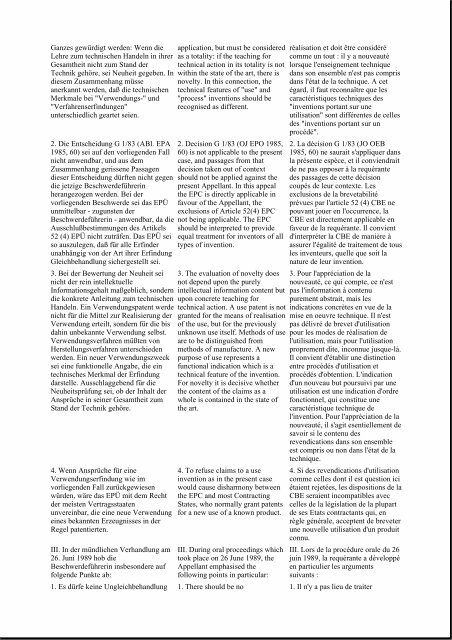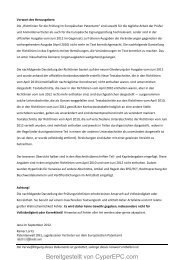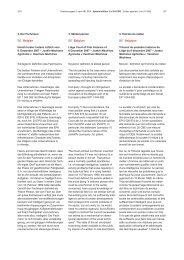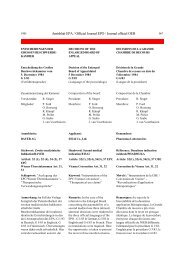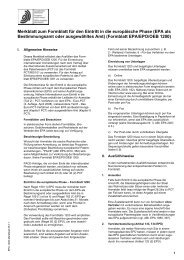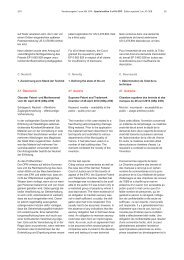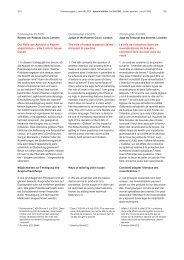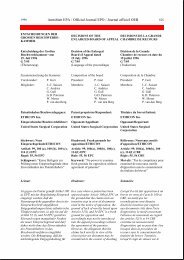Amtsblatt EPA / Official Journal EPO / Journal officiel OEB - CyberEPC
Amtsblatt EPA / Official Journal EPO / Journal officiel OEB - CyberEPC
Amtsblatt EPA / Official Journal EPO / Journal officiel OEB - CyberEPC
Create successful ePaper yourself
Turn your PDF publications into a flip-book with our unique Google optimized e-Paper software.
Ganzes gewürdigt werden: Wenn dieLehre zum technischen Handeln in ihrerGesamtheit nicht zum Stand derTechnik gehöre, sei Neuheit gegeben. Indiesem Zusammenhang müsseanerkannt werden, daß die technischenMerkmale bei "Verwendungs-" und"Verfahrenserfindungen"unterschiedlich geartet seien.2. Die Entscheidung G 1/83 (ABl. <strong>EPA</strong>1985, 60) sei auf den vorliegenden Fallnicht anwendbar, und aus demZusammenhang gerissene Passagendieser Entscheidung dürften nicht gegendie jetzige Beschwerdeführerinherangezogen werden. Bei dervorliegenden Beschwerde sei das EPÜunmittelbar - zugunsten derBeschwerdeführerin - anwendbar, da dieAusschlußbestimmungen des Artikels52 (4) EPÜ nicht zuträfen. Das EPÜ seiso auszulegen, daß für alle Erfinderunabhängig von der Art ihrer ErfindungGleichbehandlung sichergestellt sei.3. Bei der Bewertung der Neuheit seinicht der rein intellektuelleInformationsgehalt maßgeblich, sonderndie konkrete Anleitung zum technischenHandeln. Ein Verwendungspatent werdenicht für die Mittel zur Realisierung derVerwendung erteilt, sondern für die bisdahin unbekannte Verwendung selbst.Verwendungsverfahren müßten vonHerstellungsverfahren unterschiedenwerden. Ein neuer Verwendungszwecksei eine funktionelle Angabe, die eintechnisches Merkmal der Erfindungdarstelle. Ausschlaggebend für dieNeuheitsprüfung sei, ob der Inhalt derAnsprüche in seiner Gesamtheit zumStand der Technik gehöre.4. Wenn Ansprüche für eineVerwendungserfindung wie imvorliegenden Fall zurückgewiesenwürden, wäre das EPÜ mit dem Rechtder meisten Vertragsstaatenunvereinbar, die eine neue Verwendungeines bekannten Erzeugnisses in derRegel patentierten.III. In der mündlichen Verhandlung am26. Juni 1989 hob dieBeschwerdeführerin insbesondere auffolgende Punkte ab:application, but must be consideredas a totality: if the teaching fortechnical action in its totality is notwithin the state of the art, there isnovelty. In this connection, thetechnical features of "use" and"process" inventions should berecognised as different.2. Decision G 1/83 (OJ <strong>EPO</strong> 1985,60) is not applicable to the presentcase, and passages from thatdecision taken out of contextshould not be applied against thepresent Appellant. In this appealthe EPC is directly applicable infavour of the Appellant, theexclusions of Article 52(4) EPCnot being applicable. The EPCshould be interpreted to provideequal treatment for inventors of alltypes of invention.3. The evaluation of novelty doesnot depend upon the purelyintellectual information content butupon concrete teaching fortechnical action. A use patent is notgranted for the means of realisationof the use, but for the previouslyunknown use itself. Methods of useare to be distinguished frommethods of manufacture. A newpurpose of use represents afunctional indication which is atechnical feature of the invention.For novelty it is decisive whetherthe content of the claims as awhole is contained in the state ofthe art.4. To refuse claims to a useinvention as in the present casewould cause disharmony betweenthe EPC and most ContractingStates, who normally grant patentsfor a new use of a known product.III. During oral proceedings whichtook place on 26 June 1989, theAppellant emphasised thefollowing points in particular:réalisation et doit être considérécomme un tout : il y a nouveautélorsque l'enseignement techniquedans son ensemble n'est pas comprisdans l'état de la technique. A cetégard, il faut reconnaître que lescaractéristiques techniques des"inventions portant sur uneutilisation" sont différentes de cellesdes "inventions portant sur unprocédé".2. La décision G 1/83 (JO <strong>OEB</strong>1985, 60) ne saurait s'appliquer dansla présente espèce, et il conviendraitde ne pas opposer à la requérantedes passages de cette décisioncoupés de leur contexte. Lesexclusions de la brevetabilitéprévues par l'article 52 (4) CBE nepouvant jouer en l'occurrence, laCBE est directement applicable enfaveur de la requérante. Il convientd'interpréter la CBE de manière àassurer l'égalité de traitement de tousles inventeurs, quelle que soit lanature de leur invention.3. Pour l'appréciation de lanouveauté, ce qui compte, ce n'estpas l'information à contenupurement abstrait, mais lesindications concrètes en vue de lamise en oeuvre technique. Il n'estpas délivré de brevet d'utilisationpour les modes de réalisation del'utilisation, mais pour l'utilisationproprement dite, inconnue jusque-là.Il convient d'établir une distinctionentre procédés d'utilisation etprocédés d'obtention. L'indicationd'un nouveau but poursuivi par uneutilisation est une indication d'ordrefonctionnel, qui constitue unecaractéristique technique del'invention. Pour l'appréciation de lanouveauté, il s'agit esentiellement desavoir si le contenu desrevendications dans son ensembleest compris ou non dans l'état de latechnique.4. Si des revendications d'utilisationcomme celles dont il est question iciétaient rejetées, les dispositions de laCBE seraient incompatibles aveccelles de la législation de la plupartde ses Etats contractants qui, enrègle générale, acceptent de breveterune nouvelle utilisation d'un produitconnu.III. Lors de la procédure orale du 26juin 1989, la requérante a développéen particulier les argumentssuivants :1. Es dürfe keine Ungleichbehandlung 1. There should be no 1. Il n'y a pas lieu de traiter


